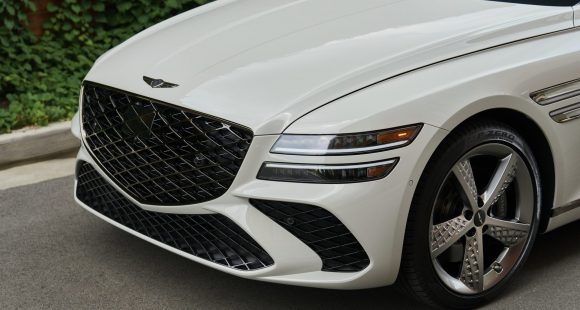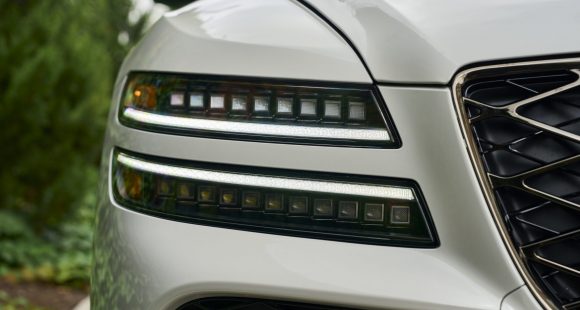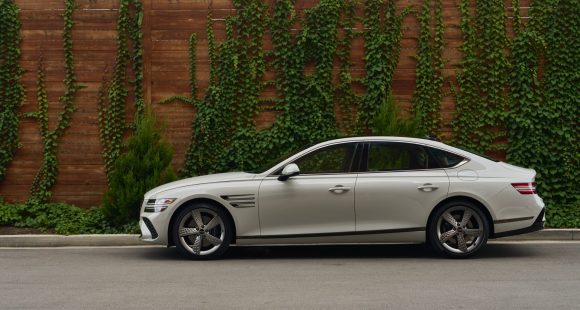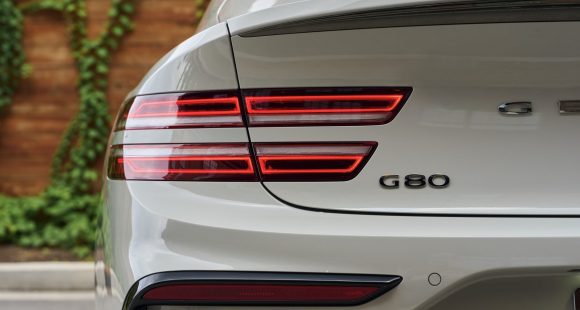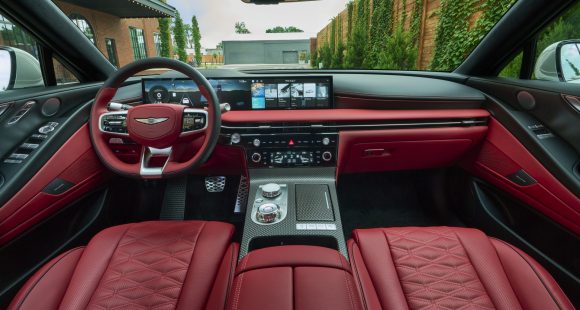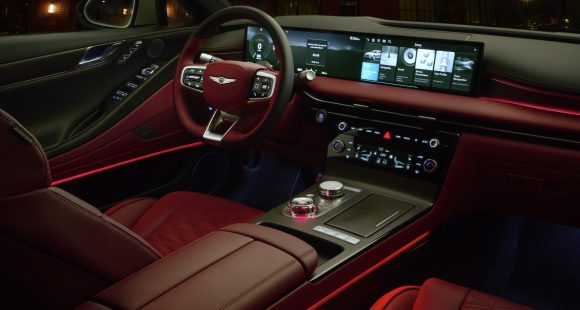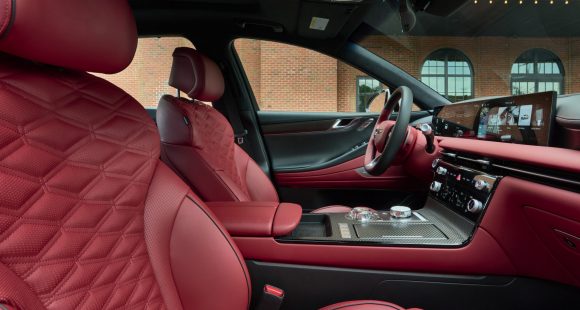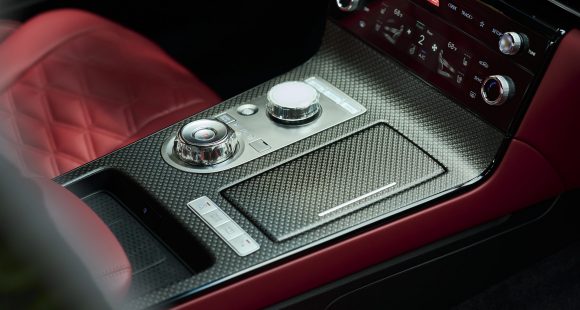2010 GMC Terrain
With sales of its surviving four brands doing well, General Motors appears on the road to recovery. A big reason is a steady stream of attractive new models. Case in point, the 2010 GMC Terrain. While sharing its mechanicals with the popular Chevrolet Equinox crossover utility, the Terrain shuns pure badge engineering, and dons the distinct, angled look of a more traditional SUV. Now, let’s see if it drives the same way.
While the 2010 GMC Terrain shares the Equinox’s compact-to-midsize Theta unitized chassis, it’s more “tough truck” shape ends up being about 2.5 inches shorter in overall length. So, to the eye, Terrain is stouter than the sleeker Equinox, and more along the lines of the venerable Jeep Cherokee.
The Terrain’s visual macho starts with projector-beam headlights, stacked to either side of a massive chrome GMC grille, which drops low into a deep, substantial-looking front fascia. The Terrain’s pronounced, squared-off fenders house wheels from 17 to 19 inches. Our tester split the difference, with six-spoke 18-inch alloys.
Standard roof rails proved useful, and fit the Terrain’s stance nicely. We also like the blacked-out D-pillars that give the impression of a wraparound rear greenhouse. Ditto the rear wiper that appears to float above a chrome bar connecting big, wide taillights. It shares no sheetmetal with the Equinox, but pop the Terrain’s hood, and things are happily familiar.
 Our all-wheel drive tester sported the same direct-injected Ecotec 2.4-liter four we applauded in the Equinox. Ratings are 182 horsepower and 172 pound-feet of torque. A 3.0-liter direct-injected V6 is optional with 264 horsepower and 222 pound-feet of torque, and when properly equipped, a trailer tow limit of 3,500 pounds.
Our all-wheel drive tester sported the same direct-injected Ecotec 2.4-liter four we applauded in the Equinox. Ratings are 182 horsepower and 172 pound-feet of torque. A 3.0-liter direct-injected V6 is optional with 264 horsepower and 222 pound-feet of torque, and when properly equipped, a trailer tow limit of 3,500 pounds.
In front or all-wheel drive, engines attached to a six-speed automatic with manual mode. Four-cylinders get an “Eco mode” which lowers shift points for better fuel economy.
This combo gives Terrain the same stellar fuel economy as Equinox. Our all-wheel drive four has Government Fuel Economy Ratings of 20 miles-per-gallon city and 29 highway. We managed an excellent 27.5 miles-per-gallon on regular gas. Our Terrain’s Energy Impact Score stands at a modest 14.9 barrels of oil consumed annually, and its Carbon Footprint of 8 tons of CO2 is likewise light-footed.
But, at the track, our Terrain loped from a standstill to 60 in 9.7 seconds. That’s about a second slower than the front-drive Equinox we tested last fall. Shifts came slow, even in manual mode. The quarter mile came in at 17.3 seconds at 83 miles-per-hour. Beyond times, however, the 2.4 felt plenty strong for highway passing, especially between five and seven thousand rpm.
The Terrain’s low power-to-weight ratio proved less of a hindrance through the slalom, where it felt much lighter than its almost two-ton curb weight. It delivered impressive car-style grip, sharp turn-ins, and only modest body roll, with none of the flabbiness of a traditional SUV.
Steering was slack on center, but tightened up nicely when we asked the Terrain to dance. In the high-speed lane change, the all-independent suspension and electronic control nannies kept the rear end reassuringly in check. Stomping the ABS disc brakes from 60 yielded a short average stopping distance of 122 feet. Brake feel was excellent: smooth and firm.
 All Terrain cabins come standard with flowing lines, soft-touch materials, and six airbags. They’re setup in a sporty, twin-cockpit theme that, except for the gauge pod, has a lot in common with Equinox.
All Terrain cabins come standard with flowing lines, soft-touch materials, and six airbags. They’re setup in a sporty, twin-cockpit theme that, except for the gauge pod, has a lot in common with Equinox.
Our well-optioned SLT included a sunroof, which shed light on the nicely drawn dash, and steering wheel audio controls that put channel surfing at our fingertips.
Bluetooth connectivity also fell easily to hand. Four auxiliary power outlets and a USB port are standard, as is Active Noise Cancellation. On 2.4 Terrains, it neutralizes engine boom using the audio system’s eight speakers. Also standard is a backup camera that shows up in the rear view mirror, or on the available navigation screen.
Our Terrain’s heated, leather trimmed front seats were plenty comfortable on long hauls. Equally comfy is the split-fold rear bench that, like Equinox, reclines and slides with eight inches of travel. Also like Equinox is Terrain’s optional programmable power liftgate. Besides full open, it can be set for a lower opening to avoid contact with a garage ceiling. Once open, owners find 31.6 cubic feet of cargo room seats up, and a small-for-its-class 63.9 cubic feet seats down.
Pricing, however, is very competitive given the Terrain’s high level of standard equipment. Base four-cylinder stickers range from $24,955 for the front drive SLE, to $29,945 for the all-wheel drive SLT. The V6 adds $1500 more.
For General Motors to prosper, they will need more efforts like the 2010 GMC Terrain. This gutsy, fuel-efficient, tough looking crossover is a family slam dunk, with build quality, interior, and drivability, on par with, if not better than, any rival utility across town, and across the oceans.
Specifications
- Engine: 2.4-Liter Four
- Horsepower: 182
- Torque: 172 Lb Feet
- 0-60 MPH: 9.7 Seconds
- 1/4 Mile: 17.3 Seconds @ 83 MPH
- 60-0 MPH: 122 Feet
- EPA: 20 MPG City/ 29 MPG Highway
- Mixed Loop: 27.5 MPG
- Energy Impact: 14.9 Barrels Oil/Yr
- CO2 Emissions: 8.0 Tons/Yr
2025 Genesis G80
New Interior And New Tech Elevates G80 Sedan
Talk about bad timing. This second-generation G80 debuted at the height of a global pandemic. But that hasn’t stopped Genesis or this Bentley-on-a-budget sedan. In fact, since then, Genesis has unveiled a spectacular all-electric version and now given all G80s a makeover. So, let’s find out what a better and better-timed new G80 is ready to deliver.
Breaking into the luxury sedan scene requires going up against traditional brands with long pedigrees and legions of loyal buyers. But Hyundai has never shied away from a challenge, and has made steady progress with their Genesis brand, and hopes that a revised 2025 G80 midsize sedan will be their next step up.
Styling matters more when you’re the upstart, and the Genesis Athletic Elegance theme changes very little for ’25; just a new grille, slightly reshaped bumpers, new wheels ranging from 18 to 20 inches, and an updated color palette. The G80’s unique two-line LED headlamps get revised Micro Lens Array technology that boosts performance while minimizing the brightness for oncoming drivers.
Changes inside are much more significant with an entirely new dash and console, eliminating both the hooded gauge panel and dashtop wide info screen. Merging them together into one 27-inch wide LG panoramic display than runs from behind the steering wheel to over the center stack. There’s a bigger and more comprehensive control panel in the center stack; while the console gets less armrest coverage, more space for storage, and reshaped cupholders. The wider display is still a touchscreen, but there is also a console mounted controller if you prefer to keep it fingerprint free. Both options work well, but the controller is still too easy to confuse with the dial-like shifter.
Materials are on par if not a notch above most European luxury rivals, and there are 18 speakers to crank out 1,400 watts of premium sound from Bang & Olufsen. Top Sport Prestige trim comes with Nappa leather seats, carbon fiber trim, micro-suede materials for the headliner and pillar covers, heated armrests, head-up display, and upgraded active safety features. Front seats are immensely comfortable without feeling overly soft, and there’s plenty of comfort and room for adults in the back seat.
More Bentley than Benz; streaking down the track with European-style solidity that gives you very little indication of the high speed you’re traveling at.
Same powertrains as last year. Base power comes from a 300-horsepower 2.5-liter turbo-four; the upgrade is this 3.5-liter twin-turbo V6 that outputs 375 horsepower and 391 lb-ft of torque. Both are hitched to standard all-wheel drive. At our Mason Dixon Dragway test track, the AWD delivered enough grip for consistent slip-free launches. We hit 60 in 5.0 seconds flat. Run after run, the 3.5T pulled as strong as it sounds. All G80s work with the same paddle-shift eight-speed automatic transmission, and while shifting was silky smooth on the street, here on the track with Sport Mode and wide-open throttle they were noticeably firmer and quicker.
It was a very surreal experience in the cabin. More Bentley than Benz; streaking down the track with European-style solidity that gives you very little indication of the high speed you’re traveling at. For us, that was 105 mph in 13.4 seconds at the quarter. In addition to the G80’s Sport Mode that tightens steering, improves throttle response, adjusts shifting points, firms up the suspension, and reconfigures stability system parameters; Sport Prestige trim adds rear-wheel steering and an electronic limited slip differential. But, even with all of that, it didn’t feel overly sporty in our handling course. Now, we were able to comfortably carry quite a bit of speed through the cones, but there was just an overall soft, somewhat disconnected and heavy presence that had us unsure of how hard we could push. Sport Prestige also adds upgraded performance brakes. They were plenty capable, bringing this 4,600-lbs. luxury liner consistently down from 60 in just 104 feet with little fade.
Government Fuel Economy Ratings for the six-cylinder are 16 City, 24 Highway, and 19 Combined. We averaged a good 21.3 mpg of Premium. Still, that’s a slightly below average Energy Impact Score, using 15.7 barrels of oil annually with 7.8 tons of CO2 emissions.
Considering the amount of luxury packed into the G80, its $58,350 starting price, even though slightly higher than last year, remains pretty remarkable. It’s a substantial step up to the 3.5T though, as it begins at $70,850.
Genesis has existed as a standalone luxury brand for just less than a decade, and it has indeed been making steady progress into what is surely the hardest segment of all to master. The 2025 Genesis G80 sedan continues to impress and is a great option for luxury-minded buyers who prioritize true value over badges.
Specifications
As Tested
- Engine: 3.5-liter twin-turbo V6
- Transmission: eight-speed automatic
- Horsepower: 375
- Torque: 391 lb-ft
- EPA: 16 City | 24 Highway | 19 Combined
- 0-60 mph: 5.0 seconds
- 1/4 Mile: 13.4 seconds at 105 mph
- Braking, 60-0 (avg.): 104 feet
- MW Fuel Economy: 21.3 mpg (Premium)















